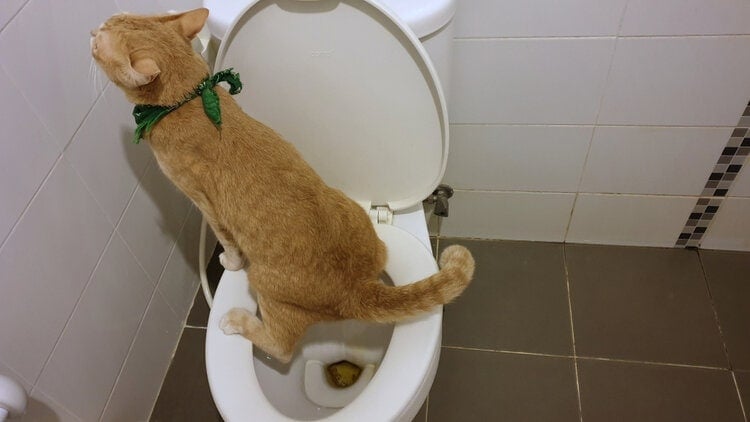Just about every person is bound to have their private theory on the subject of Don’t flush cat feces down the toilet.

Introduction
As pet cat owners, it's vital to bear in mind how we take care of our feline good friends' waste. While it may appear convenient to purge pet cat poop down the bathroom, this technique can have harmful effects for both the environment and human health and wellness.
Alternatives to Flushing
Thankfully, there are more secure and a lot more responsible methods to deal with feline poop. Take into consideration the following options:
1. Scoop and Dispose in Trash
The most typical approach of taking care of pet cat poop is to scoop it into a biodegradable bag and toss it in the garbage. Make certain to utilize a dedicated trash inside story and deal with the waste immediately.
2. Usage Biodegradable Litter
Choose naturally degradable pet cat litter made from materials such as corn or wheat. These clutters are environmentally friendly and can be securely disposed of in the trash.
3. Hide in the Yard
If you have a backyard, consider burying cat waste in a marked location far from veggie gardens and water sources. Make certain to dig deep adequate to stop contamination of groundwater.
4. Set Up a Pet Waste Disposal System
Invest in a pet garbage disposal system particularly developed for pet cat waste. These systems utilize enzymes to break down the waste, decreasing smell and environmental influence.
Health and wellness Risks
In addition to ecological concerns, purging cat waste can additionally pose wellness risks to people. Pet cat feces may consist of Toxoplasma gondii, a parasite that can trigger toxoplasmosis-- a possibly extreme disease, specifically for expectant women and individuals with damaged body immune systems.
Environmental Impact
Flushing cat poop introduces damaging virus and bloodsuckers right into the water, posturing a substantial threat to aquatic environments. These impurities can negatively affect marine life and compromise water quality.
Final thought
Liable animal ownership prolongs beyond providing food and sanctuary-- it also includes correct waste administration. By avoiding flushing feline poop down the commode and opting for alternate disposal approaches, we can decrease our environmental impact and protect human wellness.
Why Can’t I Flush Cat Poop?
It Spreads a Parasite
Cats are frequently infected with a parasite called toxoplasma gondii. The parasite causes an infection called toxoplasmosis. It is usually harmless to cats. The parasite only uses cat poop as a host for its eggs. Otherwise, the cat’s immune system usually keeps the infection at low enough levels to maintain its own health. But it does not stop the develop of eggs. These eggs are tiny and surprisingly tough. They may survive for a year before they begin to grow. But that’s the problem.
Our wastewater system is not designed to deal with toxoplasmosis eggs. Instead, most eggs will flush from your toilet into sewers and wastewater management plants. After the sewage is treated for many other harmful things in it, it is typically released into local rivers, lakes, or oceans. Here, the toxoplasmosis eggs can find new hosts, including starfish, crabs, otters, and many other wildlife. For many, this is a significant risk to their health. Toxoplasmosis can also end up infecting water sources that are important for agriculture, which means our deer, pigs, and sheep can get infected too.
Is There Risk to Humans?
There can be a risk to human life from flushing cat poop down the toilet. If you do so, the parasites from your cat’s poop can end up in shellfish, game animals, or livestock. If this meat is then served raw or undercooked, the people who eat it can get sick.
In fact, according to the CDC, 40 million people in the United States are infected with toxoplasma gondii. They get it from exposure to infected seafood, or from some kind of cat poop contamination, like drinking from a stream that is contaminated or touching anything that has come into contact with cat poop. That includes just cleaning a cat litter box.
Most people who get infected with these parasites will not develop any symptoms. However, for pregnant women or for those with compromised immune systems, the parasite can cause severe health problems.
How to Handle Cat Poop
The best way to handle cat poop is actually to clean the box more often. The eggs that the parasite sheds will not become active until one to five days after the cat poops. That means that if you clean daily, you’re much less likely to come into direct contact with infectious eggs.
That said, always dispose of cat poop in the garbage and not down the toilet. Wash your hands before and after you clean the litter box, and bring the bag of poop right outside to your garbage bins.
https://trenchlesssolutionsusa.com/why-cant-i-flush-cat-poop/

I am very drawn to Can You Flush Cat Poo or Litter Down the Toilet? and I am assuming you liked our blog entry. In case you appreciated our blog posting please do not forget to pass it around. We love reading our article about Don’t flush cat feces down the toilet.
Schedule Service